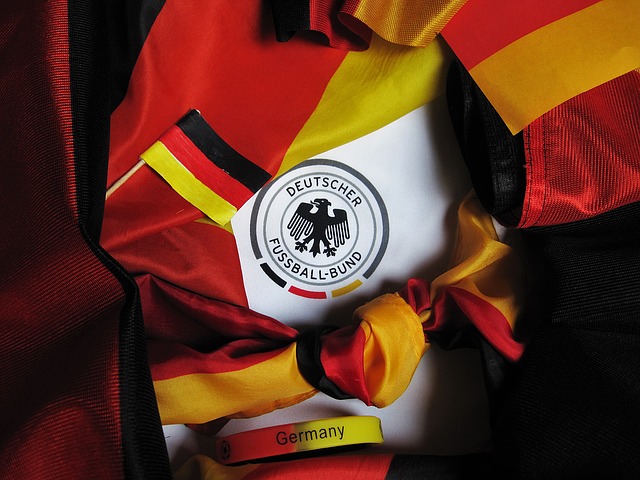What is Germany known for?
Located in the heart of the old continent, Germany is compelled of 16 states and is well known for being the largest national economy in Europe and one of the biggest in the world. With an interesting and rich history narrated by the old-fashion and colorful architecture, castles, palaces, cathedrals and monuments themselves, its landscapes, mountains and forests, delicious food and beer, Germany remains one of the top destinations in the world for travelers.
Usually when one says Germany, among the first things that come to people’s mind is Hitler, the Berlin Wall and beer. However, Germany is not all about that. Travelers who have visited the country know that Germany is actually not only an economically and politically powerful country, but it also has a rich culture, with a population that has an extraordinary respect for tradition, history and humanity.
In this article, we have listed some of the things that Germany is very well known for, and given some interesting facts on how they became so known, and what makes them so interesting.
Beer
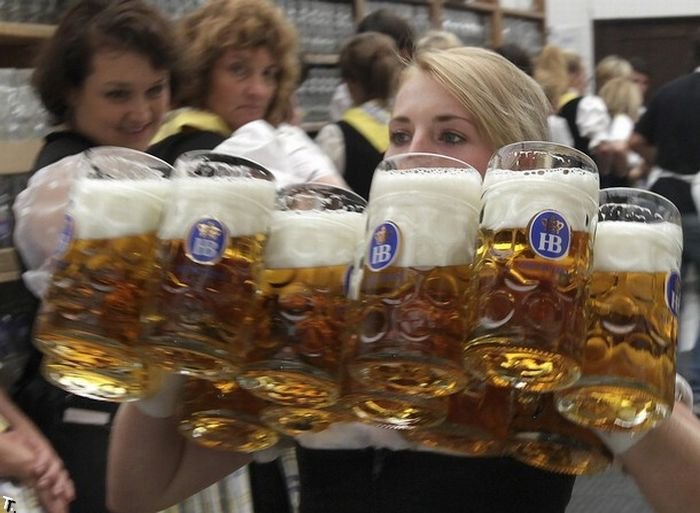
Of course, beer is the first one. Have you ever tried to think about how a German looks, and not seen him holding a huge beer mug in his hand?! Germans are the second largest beer consumers in Europe, after the Czech. Only in 2012 alone, Germans drank 2.25 gallons of beer, which is actually the lowest level since the fall of the Berlin wall in 1990.
It is estimated that the average German consumes around 140 liters of beer per year. Germans do not only love to drink beer, but they also love to brew it. There are around 1300 German breweries and 5000 brew brands that produce around 115 hectoliters of beer per year. It is estimated that if you decide to taste every day another different type of beer in Germany, you would need 15 years to taste all of them.
There is also a more than 500-hundred-year old law on beer that is called Reinheitgebot and states that only barley, hops and water shall be used in the brewing of beer.
Fun facts about beer consumption in Germany: Frederick the Great of Prussia loved beer so much that he banned coffee in 1777. On the other hand, in 1844, King Ludwig I of Bavaria attempted to impose a beer tax, which the people strongly opposed by going to the streets. The riots ended only when the King ordered a reduction in the price of beer.
Top German Beers You Must Try While in Germany
Germany may have gone through changes in its cultural repertoire and lifestyle, there’s been even a revolution in its cuisine and traditional dishes yet beer was and remains an inseparable good in every Germans life.
Amongst others, Germany’s Oktoberfest in Munich and other festivals celebrating beer in different cities around Germany show the love and devotion to this product. In Germany there are around 1300 breweries half of which only in the region of Bavaria. Most of them still operate under the Reinheitsgebot(Purity decree) which strictly allows only water, barley and hops as the only ingredients in producing beer. Once discovered, yeast and later on sugar became the other legal components.
The drinking age in Germany starts at 14 when one is allowed to drink beer or wine in the company of the parents or a legal guardian, at 16 you can drink beer but not hard liquors and once your 18 the alcohol limitations disappear. .
The alcohol percentage inside most of the beers produced in this country ranges from 4.7-5.5 with exotic exclusivities of around 16% alcohol beers illegal until recently.
Variety, Quality, Complexity, Versatility
When at a bar ordering beer, Germans tend to be highly specific about their beer style asking rather for a certain type like Pils, an Alt, a Kölsch, a Weissbier, a Helles or a Dunkel over a brand.
Pils short for pilsner refers to a light straw to golden color beer with a more bitter and earthy taste.
Altbier meaning old beer is a top fermented beer stored after fermentation for a crisper and cleaner taste.
Kölsch beer is a local specialty of the Cologne region. The end product is clear, bright yellow, distinctively bitter no too much though, less than standard lager. It has a nuttier, firmer and drier taste.
Weissbier is a top-fermented wheat beer (legally acquired with wheat beers in Germany), sour in taste and seizing a white color when cold enough. There is a peculiar serving maneuver to this type of beer, pouring rather slowly the content in a crystal clear glass, stopping to smoothly swirl the remaining sips when you’re almost at the end and pouring the well mixed and highly concentrated remains in the end. A classic, really.
Helles beer is more of a Bavarian specialty, yellow gold in color ranging from negligible to dry bitterly taste.
Dunkel or dark lagers have this smooth malty flavor ranging from amber color to dark reddish brown. Dark beers have more of a sweet firm taste and they are less bitter. The common misconception is that they have a higher percentage of alcohol, not at the very least. Here are the top beers we recommend:
Warsteiner Premium Verum
Brewed in the North-Rhine Westphalia region, 4.8 % alcohol it’s the type of beer I could drink every day, at lunch time or after work enjoying the summer breeze in my tiny bedroom balcony. It has a firm taste, slightly bitter yet it’s easy to drink loads and not get bored.
Schumacher Alt
Its secret recipe never fails. This exquisite beer is something to cherish from time to time since if overdone it loses its grace. In fact this beer is so good it’s beyond beer, it’s a phenomenon.
Früh Kölsch
This Cologne delicacy is just one among other wild beauties this city takes pride in. When served cold one cannot stop ordering, it’s like a disease, it’s contagious. This type of beer tastes differently each time, it’s more firm and nutty every time you try it.
Paulaner Weißbier
Paulaner is vastly known for being one of the beers served in Oktoberfest, the beer festival in Munchen. It the type of beer you drink when you go out on your own to grab literally “A” beer and run back home cause you have to wake up early in the morning and go to work. It’s taste is so intense it resembles your favorite dessert.
Löwenbräu Münchner Dunkel
With its distinctive dark color yet malty sweet it looks vigorous. I drink it occasionally not to spoil its magic, when I have a reason to celebrate but I don’t feel like sharing it with anyone its Löwenbräu I choose to keep me company.
Football
Germany National Football Team remains one of the strongest football teams, having won a total of four World Cups (1954, 1974, 1990, 2014) so far. Just like beer, football is a very strong trait with which Germany is identified.
Some of today’s most well-known football players are from Germany as Miroslav Klose, Toni Kroos, Manuel Neuer, and Mesut Özil, who play for teams like Real Madrid, Bayern Munich and Arsenal.
Whenever there is a match of the German National Team, or one of the German Football Clubs as Bayern Munchen or Borussia Dortmund playing at the UEFA Champions League (and even for the other teams), cafeterias, restaurants, and even the municipalities put big screens in order to show the game. A lot of people gather in front of these screens, from grandmas to kids and watch the game together while drinking beer and eating the famous German sausages.
Bread & Sausages
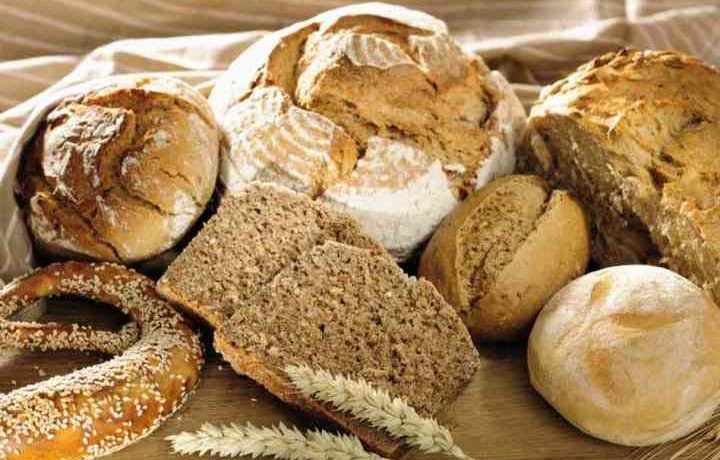
Bread is one of the main foods part of every cuisine in Germany. Germans are well known for their long tradition of baking bread, and its taste and way of cooking changes from one part of Germany to the other. There are a lot of different types of bread, loaves and rolls, dark, white, sweet, soft, plain, with different seeds and taste.
Sausages, called Wurts in Germany, are also a very important part of the German Cuisine, made of pork, beef or veal and flavored in different way depending on the region. They are mostly consumed after a mug of beer or alongside with it.
Palaces & Castles
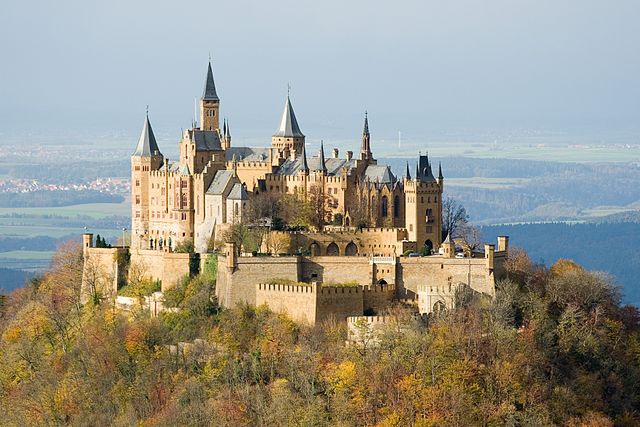
Middle Age castles and palaces built by the European nobility are among the most important buildings in the German architectural history. It is estimated that there are around 25 thousand castles throughout the whole country. The difference between castles and palaces is that the first were built for defense in a battle while the second were designed more as only a residence for the wealthy noblemen of the time.
If you are in Germany and you fail to see from close at least one castle and one palace then you have lost a lot in terms of experience and learning about Germany. Below we have listed few of the most famous palaces and castles of the country.
Sanssouci Palace
Summer Home of the legendary Friedrich the Great, King of Prussia, the palace is located in Potsdam and build in a Rococo style. It has sprawling gardens with wine grapes and fountains. From outside it looks as if it is part of a fairytale.
Schwerin Palace
This is one of the most luxury palaces in Germany, located on its own private island in the lake of Schwerin. Today it serves as a parliament for the Mecklenburg region and a public tourist destination as well. There is a legend that says the building is haunted by a troublesome little ghost called Petermännchen.
Neuschwanstein Castle
A Romanesque Revival castle build in 1869 that attracts more than 1.3 million tourists yearly, what makes it the most visited castle in the whole Germany. It was built by King Ludwig II of Bavaria and it has a striking view of the Bavarian countryside, which has been an inspiration to many creative works. You may not know, but the castle of Disney’s Sleeping Beauty was based on this one.
Cochem Castle
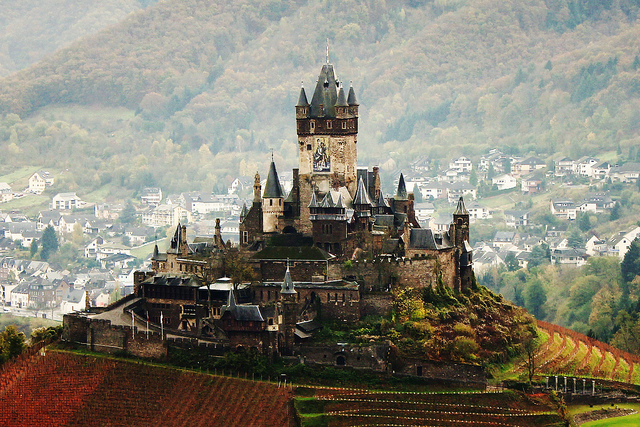
Cochem Castle by Guille Gonzalez
This one thousand-year-old castle that looks like the famous Hogwarts School of Witchcraft and Wizardry from the magical world of Harry Potter, is built in the tiny city of Cochem that has around 5,000 citizens. The castle has many towers, one of which is called Witches Towers. It is believed that during the 17th century witch-hunt, women suspected of witchcraft were thrown out of this tower to see if they survive.
Read also: 11 Extremely Marvelous Castles of Germany
Cathedrals & Monuments
Germany is home to a great number of cathedrals and monuments that date back to the BC era. Some of its most famous cathedrals date back to the 12 century, while there are monuments build in the 21th century that are listed among the most visited places by tourists in Germany.
Cologne Cathedral
The iconic Cologne Cathedral is one of the identification buildings in Germany. The Gothic cathedral started building in the 13th century and it took almost 600 years to completely build it.
Fortunately, the building survived even after being bombed 14 times in World War II. It houses the largest swinging church bell to have ever existed in the world, and it hosts 6 million visitors each year. Before the Washington Monument and the Eiffel Tower were built, Cologne Cathedral was the tallest building in the world.
Brandenburg Gate
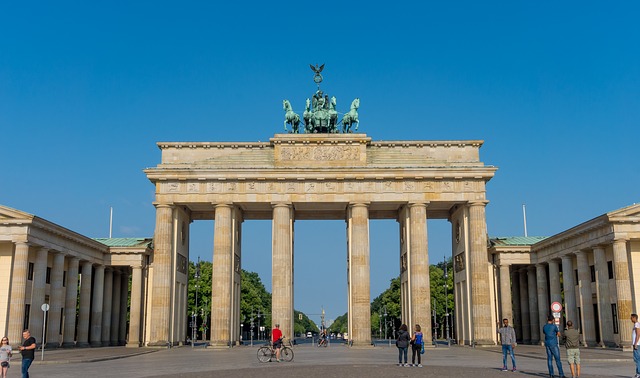
An iconic landmark located in the capital of Germany, Berlin, which is at the same time the largest city in the whole country. Build in a neoclassical style after the Acropolis in Athens and commissioned by a Prussian king as a symbol of peace, in the 18th century it served as a city gate. It also served as part of the infamous Berlin wall and was seen as a symbol of division for decades.
Memorial to the Murdered Jews of Europe
The memorial which was ceremonially opened in 2005 is built in the middle of Berlin in memory of the six million victims of holocaust. It consists of 2,711 unmarked grey concrete “stelae” located just south of the Bradenberg Gate. Since its construction, it has sparked a lot of criticism for the idea behind it and for what it represents. Still the memorial attracts a lot of visitors annually.
Festivals & Carnivals
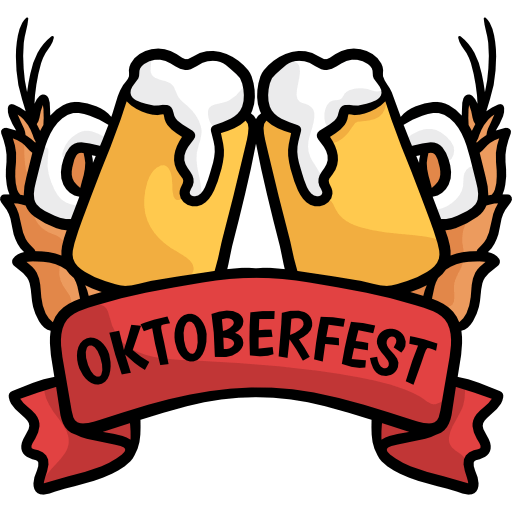
Carnivals and festivals in Germany are a joyful period of the year in which whole cities engage in all-out parties and colorful celebrations. The Carnivals have a long history in Catholicism, while today they are celebrated by street parades of people wearing costumes and masks. There is a variety of carnivals and festivals celebrating all spheres of life and joy.
The Cologne Carnivals
A carnival that takes place in the streets of the Cologne each year, and opens exactly at 11 minutes past 11 on the 11th of the 11th month November. It consists of parades, balls and stage shows. People wear different costumes and masks and celebrate in the streets singing and dancing, and of course drinking beer. The parades are of different themes, and participants wear costumes and masks according to that theme
Oktoberfest
World’s largest and one of the oldest beer and travel funfair festivals is held in Germany. Oktoberfest dates back to the beginning of the 19th century, and since then it is one of the most celebrated events in the history of Germany. The festival is all about beer, parades of restaurateurs on carriages from downtown to the festival grounds, and people in costumes. It is estimated that around 72% of the Oktoberfest participants are from Bavaria while the rest is from abroad.
Oktoberfest, one of the world’s largest fairs held annually from late September to mid’ October in the Bavarian city of Munich, is a 16 day fiesta of pride and joy not only to Germans but to tourists worldwide.
It is considered to have a vital role in the Bavarian Culture gathering around 6 million people to celebrate the tradition, drink tons of beer and enjoy the treats of German cuisine.
The city of Munich has been organizing this festival since the year 1810.
Initially on October 12, 1810 this celebration was meant to mark the marriage between Crown Prince Ludwig, later to become King Ludwig I and Princess Therese of Saxe-Hildburghausen. Held in the fields outside the city gates, the Theresienwiese (Theresa’s meadow) named after the Princess to be, the place kept its name ever since thus the German abbreviation Wiesn Fest.
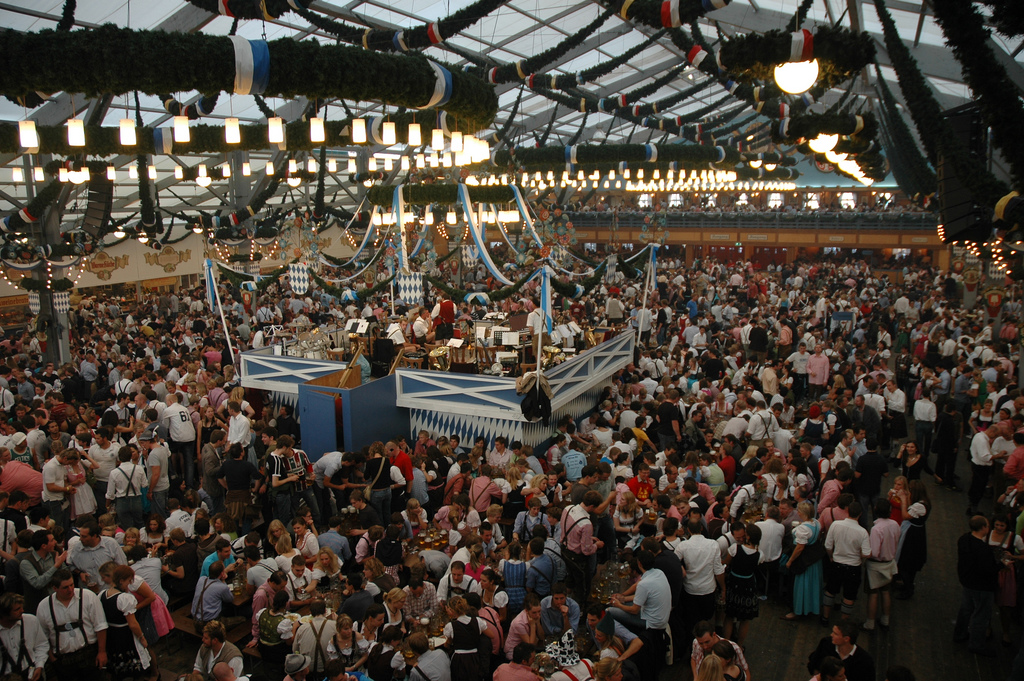
The main attraction in this festival besides gallons of quality beer being served is reviving the sanctity of that day through several flamboyant parades in lederhosen and dirndls the traditional Bavarian costumes, a rich and insightful display of its history and Bavarian delicious recipes of Chicken, Roast pork, Grilled Ham, Grilled Fish, Sausages, Pretzel, Dumplings, Cheese Noodles, Potato Pancakes, Red Cabbage and so many other finger licking treats.
The festival starts with an opening ceremony on the first Saturday of the festival which is located at the Schottenhamel tent. Since 1995 it has become a ritual for the Mayor of the City to tap the first keg of the festivals beer crying O’zapft is! (It is tapped!)
Inside the festival there are 14 larger and 20 smaller tents constructed to serve for the purpose of the festival only. Tents differ on their capacity to accommodate people and each one has a leitmotif based distinct ambient to meet the visitors preferences and expectations.
- Schottenhamel Tent– is the oldest tent in the Festival. It is famous for it hosts the opening ceremony where the mayor of Munich announces the festival to begin while tapping the first keg of beer. It has 10000 seats and is listed as the largest and mostly frequented by young and party people.
- Hippodrom– is the hippy tent, known to attract a vast number of tourists and youngsters. Besides Beer it serves Champagne and White Beer. Celebrities consider it the trendiest tent therefore it this is their favorite spot.
- Hofbräu Beer Tent– has a rich repertoire with Oompah bands and guests dressed in traditional costumes. It has been listed as highly preferred by Americans.
- Augustiner Beer Tent– is more traditional and intimate. It’s the optimal tent for families who wish to bring their kids along. It offers discount in food and beverages for the smaller ones.
- Hacker Beer Tent– is one of the largest tents. Its interior is painted in sky colors and clouds representing the Heavens of the Bavarians. There is a rock band playing in the evenings, every day and people dance to their tunes.
- Käfer’s Wies’n-Schänke– I known for its gourmet food. It has 3000 seats and hosts a less crowded and more chillaxed atmosphere. It’s a perfect spot to hide from excessive attention as most of the celebrities’ experience.
- Bräurosl Beer Tent– named after the daughter the original brewery owner (Pschorr) it’s famous for its genuine Bavarian yodeler.
- Weinzelt, The Wine Tent– is the place to be for people who prefer wine over beer. It serves around 15 types of wine and champagne along with seafood and Thai cuisine recipes.
- Löwenbräu Tent– has a 4.5 m Lion in front of the tent welcoming everyone bold enough to resist the challenge.
- Fischer Vroni– is out there to serve fish delicacies for fish lovers.
- Ochsenbraterei Tent– is famous for its ox special recipes.
- Armbrustschützen Zelt– is known to be the crossbow shooters tent.
- Winzerer Fähndl– is the preferred spot for the local football team players.
- Schuetzen Tent– is the tent hosting a shooting hall together with yummy pork servings.
This beer fest serves only beers that are produced by licensed breweries in the Munich area containing approximately 6% alcohol at most. Famous brands that meet the criteria include Loewenbraeu Oktoberfestbier, Spaten Oktoberfest Beer, Augustiner Oktoberfestbier, Hofbräu Oktoberfestbier Paulaner and Hacker-Pschorr. The price of beer has been increasing in years; it ranges from 6 to 10 euros. Beer is served in 1 l mugs by the incredibly crafted waitresses in their dirndls, holding several mugs in each hand.
A Few Facts About Oktoberbest:
- Oktoberfest starts in September
- The drinking age in Germany for hard liquor is 18 while for beer its 16.
- There is no entry fee at the festival however the cheapest beer costs around 7 euros.
- Water and Soda prices are between 4 and 6 Euros.
- The best way to get to Oktoberfest is by public transport.
- Genuine traditional costumes cost around 100-150 Euros.
- Hostels in Nuremberg, 1 hour by train are way cheaper than hostels around the festival.
- There are several tips one should follow to survive a few days in Oktoberfest
- The beer served in October fest has a higher percentage of alcohol and sugar that’s way people end up intoxicated.
- The lost and found office receives rather peculiar items lost along this restless journey.
Music festivals
In Germany, Music Festivals come alongside with spring, which are many, and even if you have a very specific taste in music, you will without a doubt find the festival that you will enjoy for every second.
Some of the most famous of these festivals are: Lollapalooza, which is the largest inner-city festival that is held in Berlin each 8 and 9 September. Fans of electronic music will love the Melt! Festival, which is organized every year in Ferropolis with famous performers. Just nearby, is organized one of Germany’s biggest hip-hop festivals, the Splash! Festival, which also takes place in the city of iron.
Cars
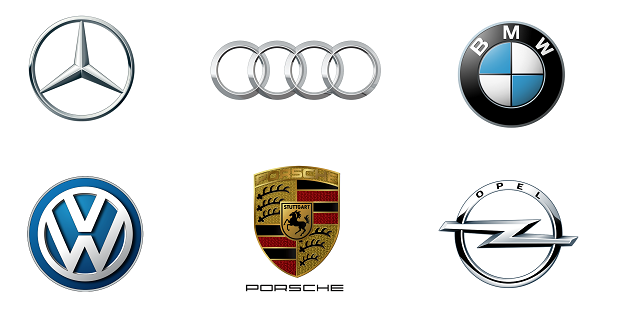
If you know just a little about cars, then you must know that some of the most popular car manufacturers are from Germany, as Audi, Volkswagen, BMW and Mercedes-Benz. There are even car museum and factory tours for tourists who are car enthusiasts. The well-maintained roads in Germany offer a great experience for drivers, what makes them love their cars even more.
Read also: Driving in Germany – Autobahn, Speed Limits, Drinking & More
Free Education

Differently from other countries, in which you will need to spend a fortune on education, in Germany education is free even for internationals. And we are not talking about primary and secondary education, since even higher education, public colleges and universities are free.
Still from these institutions have graduated and continue graduating some of the most well-known leaders, artists and scientists not only of Germany but also of the world.
Read also: 51 Most Incredible German Scientists and Innovators of All Times
Nuremberg Christmas Market
Set at the Nuremberg Main Market Square and organized each year at the most beautiful time of the year, the Nuremberg Christmas Market, or as Germans call it Christkindlesmarkt, is one of the oldest traditional Christmas markets in Germany. It is believed that it has been organized for almost every year since the early 17th century in Nuremberg.
There you can find all types of foods and drinks, starting from gingerbread, grilled sausages, blueberry Glühwein, tea, coffee and beer. You can also buy unique and handmade Christmas decorations and dolls of German Saints.


